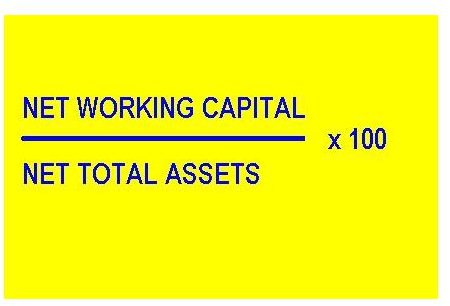Understanding Working Capital to Total Asset Ratio
Formulae
Net Working Capital to Total Asset ratio is a liquidity ratio that expresses the net current assets or working capital of a company as a percentage of its total assets.
The formula is: [Net Working Capital / Net Total Assets] x 100.
Net Working Capital, also known as Working Capital Ratio, is current assets minus current liabilities.
Current assets are liquid cash, and assets convertible to cash within one year. It includes stocks, cash, and cash equivalents available with the company, marketable securities, accounts receivables, inventories, and prepaid expenses.
Current liabilities include accounts payable, notes payable, current maturities of deposits taken, and accrued liabilities
Net Total assets include all current assets, plant and machinery, and property.
Current assets, current liabilities, and total assets make up the line items in the balance sheet.
Illustrative Example
Assume a company’s balance sheet has the following line entries:
- Cash: $6000
- Marketable Securities: $800
- Accounts receivables: $3500
- Inventory: $40000
- Land: $100000
- Accounts Payable: $3000
- Accrued Expenses $1800
- Notes Payable: $500
- Current Position Long-Term Debt: $10000
The total currents assets from the given information is (Items 1 to 4) $50300, and the total current liabilities (Items 6 to 9) is $15300.
The company’s working capital is $50300-$15300 = $35000
The company’s net total assets is (Items 1 to 5) $60300.
The working capital to total assets ratio is (35000/60300)*100 = 58.04 percent.
Uses of the Ratio
Ratio analysis helps in shedding light on the financial status of the company, and to make meaningful interpretations of the figures contained in the Balance Sheet and Statement of Income. The working capital-total assets ratio, helps stakeholders analyze the extent of assets tied up in working capital, or the amount of assets required to run the day to day operations of a company.
A high net working capital to total asset ratio shows the company’s ability to match its account payable obligations on time. Suppliers prefer to strike relationships with such companies, who would make payments on time.
The reason for a high working capital-total assets ratio, could be the company realizing revenue from sales much quicker than it makes payments for raw materials and other services. The reason could, however, also be the company not utilizing its cash reserves optimally. The money blocked as working capital usually receives a very low rate of return, and as such, companies seek to minimize working capital levels, with the concept of zero working capital, trying to do away with working capital altogether.
A low working capital to total assets ratio, usually indicates serious cash flow difficulties for the company, with the company unable to make payments to its suppliers and creditors, even when it makes profit and has assets to cover its liabilities. It could be a predictor for an imminent bankruptcy or disaster, as the reason for the low ratio could be consistent operating losses by slow sales that eat into working capital reserves, causing it to shrink relative to total assets. A low or negative ratio could however also indicate adoption of a zero working capital initiative.
Distorters
There is no optimal level of current asset to working capital ratio. Whether a high or low ratio denotes good or bad tidings for the company, depends on specific company circumstances.
A significant reason for distortion of the figures is companies experiencing a rise in working capital - total assets ratio when the sell off an asset, and the total assets, shrink relative to working capital. This could indicate a cash strapped company selling the asset to finance day-to-day operations, or it could be the company selling one low return asset to re-invest in a more remunerative opportunity.
A sudden fall in the working capital to total asset ratio, could mean the company making a significant investment or implementing zero working capital approaches.
The Working Capital to Total Asset ratio is by itself not sufficient to gauge the financial health of a company. One general rule of thumb in understanding a company’s position is to compare the working capital to net current ratio of the company, with the industry average. Other financials should then be checked, and ratios such as a profit and loss statement, cash flow statements, inventory turnover ratio, receivable ratio, and quick ratio to get a true picture.
Reference
NC State University. “Financial Statement ratios.” Retrieved from https://www2.acs.ncsu.edu/UPA/auth/compliance/standards/resource_2_measures.htm on 12 February 2011.
Image by N Nayab
